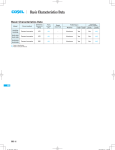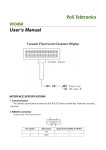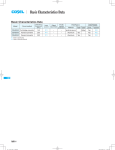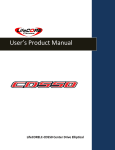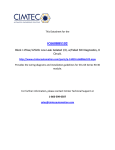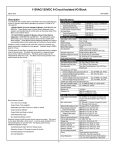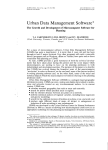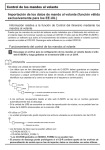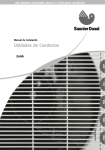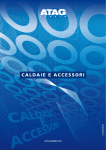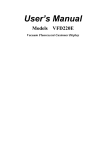Download Basic characteristics data • Instruction manual
Transcript
Basic Characteristics Data Basic Characteristics Data Model Circuit method Switching frequency [kHz] CBS50 Forward converter 310 CBS100 Forward converter 370 CBS200 Forward converter 370 Input current [A] Material Single sided Series/Redundancy operation availability Double Series Redundancy sided operation operation - Aluminum Yes Yes *1 - - Aluminum Yes Yes *1 - - Aluminum Yes Yes *1 Rated input fuse Inrush current protection Refer to table No.1 PCB/Pattern CBS350 Forward converter 370 - - Aluminum Yes Yes *1 CBS450 Forward converter 370 - - Aluminum Yes Yes *1 *1 Refer to Instruction Manual. Table1. The value of input current (at rated input voltage and rated load) Model [A] Output Voltage 1.8V 2.5V 3.3V 5V 12V 15V 24V 28V 32V 48V CBS5024 1.2 1.6 2.0 2.5 2.4 2.4 2.4 2.4 - - CBS5048 0.6 0.8 1.0 1.3 1.2 1.2 1.2 1.2 - - CBS10024 2.5 3.2 4.1 5.0 4.8 4.8 4.8 4.8 - - CBS10048 1.2 1.6 2.0 2.5 2.4 2.4 2.4 2.4 - - CBS20024 3.8 4.8 6.1 7.6 9.6 9.6 9.7 9.7 - - CBS20048 1.9 2.4 3.0 3.8 4.8 4.8 4.8 4.8 - 4.8 CBS35024 - - - - 15 - 17 17 17 14 CBS35048 - - - - 8.4 - 8.2 8.1 8.2 8.2 CBS45048 - - - - - - 10.6 10.5 9.3 - CBS CBS CBS-12 CBS_E.indd 12 15.6.19 11:37:13 AM DC-DC Converters Bus Converter.Power Module Type Instruction Manual 1 Pin Configuration CBS-14 2 Connection for Standard Use CBS-14 3 Wiring Input/Output Pin CBS-14 4 5 6 7 3.1 Wiring input pin CBS-14 3.2 Wiring output pin CBS-15 Function CBS-16 4.1 Overcurrent protection CBS-16 4.2 Overvoltage protection CBS-16 4.3 Thermal protection CBS-16 4.4 Remote ON/OFF CBS-16 4.5 Remote sensing CBS-16 4.6 Adjustable voltage range CBS-17 4.7 Withstanding Voltage / Isolation Voltage CBS-18 Series and Parallel Operation CBS-18 5.1 Series operation CBS-18 5.2 Redundancy operation CBS-18 Implementation-Mounting Method CBS-18 6.1 Mounting method CBS-18 6.2 Stress onto the pins CBS-18 6.3 Cleaning CBS-19 6.4 Soldering temperature CBS-19 6.5 Derating CBS-19 6.6 Heat sink(Optional parts) CBS-19 6.7 Addition of a Heat sink(Optional:FO) CBS-20 Safety Considerations CBS-21 CBS-13 CBS DC-DC Converters Bus Converter . Power Module Type 1 Pin Configuration Instruction Manual ¡Short the following pins to turn on the power module. -VIN RC, +VOUT +S, and -VOUT -S Reference: 4.4 4-Mounting hole 9 -VOUT -VIN 4 ”Remote ON/OFF” 4.5 ”Remote sensing” ¡Only DC voltage can be applied to CBS Series. Applying AC voltage will damage the power module. 8 -S (CBS50/100/200) CASE 3 (CBS350/450)NC 7 TRM RC 2 6 +S +VIN 1 5 +VOUT ¡The power module is designed for conduction cooling. Make sure that heat sinks, fans, etc. are used for heat dissipation. Refer to 6.5 ”Derating” Fuse +VIN Fig.1.1 Pin Configuration (bottom view) Cin DC input Co + 3 4 5 6 7 8 9 CBS No. 1 2 3 4 5 6 7 8 9 Pin Name +VIN RC NC CASE -VIN +VOUT +S TRM -S -VOUT Mounting hole Pin Name +VIN RC NC CASE -VIN +VOUT +S TRM -S -VOUT Mounting hole -VIN -VOUT CASE (CBS50/100/200) -S C Y Mounting hole (CBS350/450) Function +DC input Remote ON/OFF No connection (CBS350/450) Wiring base plate (CBS50/100/200) -DC input +DC output +Remote sensing Adjustment of output voltage -Remote sensing -DC output Mounting hole Load RC Table 1.1 Pin Assignment No. 1 2 +S +VOUT + Cin : External capacitor on the input side Co : External capacitor on the output side CY : Primary decoupling capacitor Fig.2.1 Connection for Standard Use 3 Wiring Input/Output Pin 3.1 Wiring input pin Reference 3.1 ”Wiring input pin” 4.4 ”Remote ON/OFF” (1) External fuse 3.1 ”Wiring input pin” ¡When multiple modules get input voltage from a single front-end power supply, a normal-blow fuse must be installed to each mod- ¡The input circuit of CBS Series does not come with a built-in fuse. In order to protect the power module, a normal-blow fuse should be installed to +VIN. 3.2 4.5 4.6 4.5 3.2 6.1 ”Wiring output pin” ”Remote sensing” ”Adjustable voltage range” ”Remote sensing” ”Wiring output pin” ”Mounting method” 2 Connection for Standard Use ule. Table 3.1 Recommended Fuses (Normal-Blow Type) CBS20024 CBS35024 1R8/2R5/03/05 12/15/24/28 Rated current 6A 12A 20A 25A 30A CBS20048 CBS35048 CBS5048 CBS10048 Model 1R8/2R5/03/05 12/15/24/28/48 CBS45048 Rated current 3A 6A 10A 12A 20A Model CBS5024 CBS10024 (2) Noise Filter/Grounding Capacitor ¡A grounding capacitor CY must be used to reduce the line noise on the input line and stabilize the power module operation (Fig. 2.1). Note that resonance and inductance from the input line filter ¡The power module needs input and output connections as shown in Fig. 2.1. Reference: 3 6.5 CBS-14 ”Wiring Input/Output Pin” ”Derating” may cause the power module to become unstable. ¡An appropriate filter must be used if conformance to the conducted noise regulation is required or if surge voltage may be applied to the unit. Please consult us for more details. ¡Install a grounding capacitor CY of at least 4700 pF as close to the input pins as possible (within 50mm of the pins). DC-DC Converters Bus Converter . Power Module Type ¡If the total capacitance of the grounding capacitor exceeds 15000 pF, the specified isolation voltage between input and output may Instruction Manual Input current [A] Input voltage range not be satisfied. In this case, either reduce the capacitance of the grounding capacitor at the input or install a grounding capacitor to the output. There is no maximum limit to capacitance CY when the power lp module is used with an isolation voltage of less than 500VAC (1 Input voltage [V] min.) between input and output. Fig.3.2 Input Current Characteristics (3) External Capacitor on the Input (5) Reverse Input Voltage Protection ¡An external capacitor Cin must be installed between +VIN and -VIN to reduce line noise and stabilize the power module operation (Fig. 2.1). ¡Avoid applying reversed-polarity voltage to the power module as it will damage the power module. To protect the power module from reversed polarity voltage, installing an external diode as shown in Fig. 3.3 is recommended. Capacitance CBS50/100/20024:at least 68 F CBS35024:at least 220 FX2 CBS50/100/20048:at least 33 F CBS35048:at least 68 FX2 CBS45048:at least 68 FX2 Tc=-20 to +100C Electrolytic or Ceramic capacitor (a) (b) +VIN DC IN -VIN +VIN DC IN -VIN Tc=-40 to +100C Ceramic capacitor ¡The capacitor must be installed less than 50mm of the power module. As ripple current will flow through this capacitor, pay at- 3.2 Wiring output pin tention to the ripple current rating of the capacitor. ¡If the power module is to be turned ON/OFF directly with a switch, inductance from the input line will induce a surge voltage several times that of the input voltage and it may damage the power module. Make sure that the surge is absorbed, for example, by connecting an electrolytic capacitor between the input pins. (4) Input Voltage Range/Input Current Range ¡Install an external capacitor Co between +VOUT and -VOUT to increase stability of output (Fig. 2.1). Recommended capacitance of Co is shown in Table 3.2. ¡Choose a high frequency type electrolytic capacitor for Co. Output ripple and rise time will be influenced by the capacitor’s ESR and ESL and the wiring impedance. ¡Keep the input voltage ripple within the specifications below. Output ripple voltage will increase as these values increase. Ripple voltage Fig.3.3 Reverse Input Voltage Protection ¡As ripple current will flow through capacitor Co, pay attention to the ripple current rating of the capacitor. CBS50/100/200/35024:less than 2Vp-p ¡Install capacitor Co as close to the power module as possible (within 50mm). CBS50/100/200/35048:less than 4Vp-p This is useful for reducing radiated noise and increasing stability CBS45048:less than 4Vp-p ¡Make sure that the peak input voltage stays within the specified input voltage range of the power module. Ripple voltage Time Fig.3.1 Input Voltage Ripple t Input voltage range Input voltage [V] ¡Choose a front end power supply that can supply enough current Ip (Fig. 3.2) for starting up the power module. of the power module operation. Table 3.2 Recommended Capacitance for External Output Capacitor Co ( F) Base plate temperature : Tc=-20 to +100C VOUT 1.8V/2.5V/3.3V/5V 12V 15V 24V 28V 32V CBS50 2200 470 220 CBS100 2200 470 220 CBS200 2200 1000 470 CBS350 470 220 CBS450 220 Base plate temperature : Tc=-40 to +100C VOUT 1.8V/2.5V/3.3V/5V 12V 15V 24V 28V 32V CBS50 2200X2 470X2 220X2 CBS100 2200X2 470X2 220X2 CBS200 2200X2 1000X2 470X2 CBS350 470X3 220X3 CBS450 220X3 48V 330 48V 330X3 CBS-15 CBS DC-DC Converters Bus Converter . Power Module Type ¡The specified ripple and ripple noise are measured by the method introduced in Fig. 3.4. CBS50/100/200 Remarks: Note that devices inside the power module may fail when a voltage greater than the rated output voltage is applied from an exter- 50mm Measuring board +S Instruction Manual nal power supply to the output terminal of the power module. This could happen in in-coming inspections that include OVP function test or when voltage is applied from the load circuit. OVP can be +VIN +VOUT tested by using the TRM terminal. Consult us for details. DC input Cin + Co RC + 0.1 F Load 4.3 Thermal protection -VIN -VOUT ¡Over Temperature Protection (OTP) is built in. If the base plate temperature exceeds 100C, OTP will work, causing the output 4700pF CASE -S voltage to drop. Output voltage can be recovered by shutting Oscilloscope BW : 20MHz down DC input for at least one second or by turning RC off for one CBS350 CBS350/450 second without shutting down the DC input. 50mm Measuring board +S ¡The remote ON/OFF function is incorporated in the input circuit and operated with RC and -VIN. If positive logic control is re- +VIN +VOUT DC Cin + input Co RC + 0.1 F 4.4 Remote ON/OFF Load quired, order the power module with ”-R” option. -VIN -VOUT 4700pF Table 4.1 Remote ON/OFF Specifications Mounting -S hole Oscilloscope BW : 100MHz R ON/OFF logic 1.5m 50W Coaxial Cable C R=50W C=0.01 F Fig.3.4 Method of Measuring Output Ripple and Ripple Noise CBS Standard Negative Optional -R Positive Between RC and -VIN L level(0 - 1.2V) or short H level(3.5 - 7.0V) or open L level(0 - 1.2V) or short H level(3.5 - 7.0V) or open Output voltage ON OFF OFF ON ¡When RC is at low level, a current of 0.5mA typ will flow out. When Vcc is used, keep it within the following rage: 3.5 [ VCC [ 7V. When remote ON/OFF is not used, short RC and -VIN. 4 Function Vcc RC RC 4.1 Overcurrent protection ¡Over Current Protection (OCP) is built in and works at 105% of the rated current or higher. However, use in an over current situation must be avoided whenever possible. The output voltage of the power module will recover automatically if the fault causing over -VIN -VIN Opto coupler Transistor RC RC -VIN -VIN IC Relay Fig. 4.1 RC Connection Example current is corrected. When the output voltage drops after OCP works, the power module enters a ”hiccup mode” where it repeatedly turns on and off at a certain frequency. 4.2 Overvoltage protection 4.5 Remote sensing (1) When Remote Sensing is Not Used +S +VOUT ¡Over Voltage Protection (OVP) is built in. When OVP works, output voltage can be recovered by shutting down DC input for at least one second or by turning off the remote control switch for one second without shutting down the DC input. The recovery time varies according to input voltage and input capacitance. CBS-16 + Co -VOUT -S Short at pin root Fig. 4.2 When Remote Sensing is Not Used Load ¡Keep the patterns between +S and +VOUT and between -S and -VOUT as short as possible. Avoid a looping pattern. If noise enters the loop, the operation of the power module will become unstable. (2) When Remote Sensing is Used Instruction Manual 110 105 100 32,48 80 60 12,24,28 0 0 20 21 22 23 ADJUSTMENT RANGE [%] ¡When remote sensing is not used, make sure +VOUT and +S are shorted, and that -VOUT and -S are shorted as well. ADJUSTMENT RANGE [%] DC-DC Converters Bus Converter . Power Module Type 48 115 110 105 100 32,48 80 60 12,24,28 0 0 36 INPUT VOLTAGE [V] CBS35024OO Wire as close as possible 38 40 42 INPUT VOLTAGE [V] CBS35048OO Fig. 4.4-1 CBS350 Output Voltage Adjustment Range The output adjustment range for CBS450 is shown in Fig. 4.4-2. +S Co Load Fig. 4.3 When Remote Sensing is Used ¡Using remote sensing with long wires may cause output voltage to become unstable. Consult us if long sensing wiring is necessary. ¡Sensing patterns or wires should be as short as possible. If wires are used, use either twisted-pair or shielded wires. ¡Use wide PCB patterns or thick wires between the power module and the load. Line drop should be kept less than 0.3V. Make sure output voltage from the power module stays within the specified range. ¡If the sensing patterns are shorted by mistake, a large current may flow and damage the pattern. This can be prevented by installing fuses or resistors close to the load. As wiring or load impedance may generate oscillation or large 26.0 25.0 24.0 19.2 0 0 Output voltage will increase if the resistance between 1 and 2 is reduced by turning the potentiometer clockwise. Recommended values for external components are shown in Table 4.2. Consult us if the power module is used in a different configuration. ¡Output voltage between +VOUT and -VOUT can be adjusted by connecting external resistors to TRM. 30.8 28.0 16.8 0 0 3640 32.0 25.6 0 0 76 36 40 INPUT VOLTAGE [V] CBS4504832 ¡The wiring to the potentiometer should be as short as possible. As the ambient temperature fluctuation characteristics deteriorates depending on the types of resistors and potentiometers used, please use resistors and potentiometers of the following specifications: Resistors ............. Metal film type, coefficient less than ±100ppm/C Potentiometers ... Cermet type, coefficient less than ±300ppm/C ¡When output voltage adjustment is not required, open TRM. ¡Note that, when adjusting output voltage, setting output voltage too high may cause OVP to work. +S +VOUT 20024 or 36 - 40VDC with CBS50/100/20048, the output voltage for 1.8/2.5/48V output models. - Control Amp. of rated voltage range becomes as shown in Fig. 4.4-1. RA 3kW 2.5V TRM 2 + When input voltage is 20 - 22VDC with CBS35024 models or 36 - 40VDC with CBS35048 models, the output voltage adjustment CBS Fig. 4.4-2 CBS450 Output Voltage Adjustment Range However, when the input voltage is 18 - 20VDC with CBS50/100/ adjustment range is 60 - 105% of the rated output voltage except 76 60 INPUT VOLTAGE [V] CBS4504828 35.2 given in advance. ¡Output voltage can be adjusted by connecting an external potentiometer (VR1) and resistors (R1 and R2) as shown in Fig. 4.5. 32.2 INPUT VOLTAGE [V] CBS4504824 fluctuations in output voltage, make sure enough evaluation is 4.6 Adjustable voltage range 57 60 38 40 OUTPUT VOLTAGE [V] + OUTPUT VOLTAGE [V] -VOUT -S OUTPUT VOLTAGE [V] +VOUT RB VOUT RB 1.8V 1.3kW 2.5V 1.8kW 3.3 - 48V 3kW RC 1kW R2 -VOUT -S R1 1 VR1 5kW 3 Fig. 4.5 Connecting External Parts CBS-17 DC-DC Converters Bus Converter . Power Module Type Table 4.2 Recommended Values of External Resistors No. VOUT 1 2 3 4 5 6 7 8 9 10 1.8V 2.5V 3.3V 5V 12V 15V 24V 28V 32V 48V Adjustable range VOUT±5% VOUT±10% R1 R2 R1 R2 1.8kW 6.2kW 1.6kW 3.6kW 2.7kW 7.5kW 2.4kW 4.7kW 2.4kW 2.4kW 5.6kW 5.6kW 18kW 18kW 24kW 24kW 11kW 6.8kW 43kW 39kW 51kW 47kW 56kW 56kW 82kW 82kW Instruction Manual ¡Even a slight difference in output voltage can affect the balance between the values of I1 and I2. Please make sure that the value of I3 does not exceed the rated current of a power supply. I3 the rated current value 6 ImplementationMounting Method 6.1 Mounting method 4.7 Withstanding Voltage / Isolation Voltage ¡When testing the withstanding voltage, make sure the voltage is increased gradually. When turning off, reduce the voltage gradually by using the dial of the hi-pot tester. Do not use a voltage tester with a timer as it may generate voltage several times as large as the applied voltage. ¡When multiple power modules are used side by side, position them with sufficient spaces to allow adequate air ventilation so that the aluminum base plate temperature of each power module will remain within the temperature range shown in the derating curves (Fig. 6.2). ¡Do not pass the DC input pattern underneath the power module as this will increase conducted noise. Place the DC input pattern away from the power module. 5 Series and Parallel Operation Do not pass the DC output pattern underneath the power module as this will increase output noise. Place the DC output pattern away from the power module. ¡High frequency noise is radiated from the power module. When mounting the power module on a PCB, leave a copper pattern on the PCB to let it act as a shield and connect this pattern to the CASE pin (CBS50/100/200) or the mounting hole. ¡Multiple CBS units can be used in series. Keep the output current less than the smallest specified rated current of the modules connected in series. Make sure the current flown into the power module will not exceed the rated current. (a) ing a M3 tap on the heat sink. In case of CBS350/450, make sure a mounting hole will be connected to a grounding capacitor CY. Table 6.1 Mounting Hole Configuration Load Power Supply Power Supply Power Supply 5.2 Redundancy operation I3 ¡Input and output pins are soldered onto the internal PCB. Do not bend or pull the leads with excessive force. ¡As unexpected stress may be applied to the pins, set the diameter of the PCB mounting hole at 3.5mm. ¡As unexpected stress may be applied to the pins from vibration or shock, fix the power module by using the mounting holes with Load -VOUT -S +S +VOUT ¡Applying excessive stress to the input or output pins of the power module may damage internal connections. Avoid applying stress in excess of that shown in Fig. 6.1. ¡Parallel operation is not possible. ¡Redundancy operation is available by wiring as shown below. I1 Mounting hole M3 tapped f3.4 thru 6.2 Stress onto the pins Fig. 5.1 Examples of Series Operation +S +VOUT Standard Optional : -T Load Power Supply I2 -VOUT -S CBS-18 ¡When a heat sink cannot be fixed on the base plate side, order the power module with ”-T” option. A heat sink can be mounted by affix- (b) Load CBS 5.1 Series operation Fig. 5.2 Example of Redundancy Operation screws to reduce stress. ¡Fix the power module to the PCB with the screws before soldering the input and output pins to prevent the PCB pattern being damaged. DC-DC Converters Bus Converter . Power Module Type 100 (85.7) (83.3) Load factor[%] -VOUT -S TRM -VIN CASE NC RC +S +VOUT +VIN 2 1CBS3502412,CBS3502448,CBS3504848 2Others (CBS350) 50 (15) 0 -40 +VOUT, -VOUT -20 Others Less than 19.6N(2kgf) Less than 19.6N(2kgf) Less than 19.6N(2kgf) Less than 39.2N(4kgf) Load factor[%] Less than 39.2N(4kgf) 0 20 40 (85) 80 60 100 110 (75) CBS450 50 (15) 0 Fig. 6.1 Stress onto Pins 1 Aluminum base plate temperature Tc [C] 100 Less than 39.2N(4kgf) Instruction Manual -40 -20 0 20 40 (85) 80 60 100 110 Aluminum base plate temperature Tc [C] 6.3 Cleaning Tc:Measuring point ¡Clean the soldered side of the power module with a brush. Prevent liquid from getting into the power module. Do not clean by soaking the power module into liquid. ¡Do not allow solvent to come in contact with product labels or resin cases as this may change the color of the resin case or cause Aluminum base plate deletion of the letters printed on the product label. ¡After cleaning, dry the power modules well. Fig.6.2 Derating Curve 6.4 Soldering temperature 6.6 Heat sink(Optional parts) ¡Flow soldering: 260C for up to 15 seconds. ¡Soldering iron (26W): 450C for up to 5 seconds. ¡The power module works with conduction cooling and needs heat dissipation using heat sinks. Optional heat sinks are available for CBS Series. Refer to Table 6.2 for details on the thermal resis- 6.5 Derating tance of heat sinks. ¡Use the power modules with conduction cooling (e.g. heat dissipation from the aluminum base plate to the attached heat sink). Fig. 6.2 shows the derating curves with respect to the aluminum Table 6.2 Types of Heat Sinks Available Size[mm] No. Model 1 2 3 4 5 6 F-CBS-F1 F-CBS-F2 F-CBS-F3 F-CBS-F4 F-CBS-F5 F-CBS-F6 base plate temperature. Note that operation within the hatched areas will cause a significant level of ripple and ripple noise. Contact us for more information on cooling methods. ¡It is necessary to note thermal fatigue life by power cycle. Please reduce the temperature fluctuation range as much as possible when the up and down of temperature are frequently generated. Contact for more information on cooling methods. W D 12.7 12.7 25.4 25.4 38.1 38.1 57.9 58.4 57.9 58.4 57.9 58.4 61.5 61.0 61.5 61.0 61.5 61.0 Thermal resistance[C/W] Convection Forced Air (0.1m/s) 7.5 4.6 3.0 Style Horizontal Vertical Horizontal Refer Fig.6.4 Vertical Horizontal Vertical W W 2 1 100 Load factor[%] H 1CBS200O12,15,24,28,48 2Others (Excluding CBS350/450) 50 D D 0 -40 -20 0 20 40 60 (85) 80 100 110 Aluminum base plate temperature Tc [C] H H Horizontal Vertical Fig.6.3 Heat Sink Types CBS-19 CBS DC-DC Converters Bus Converter . Power Module Type ¡Derating curve characteristics with respect to aluminum base plate temperature are shown in Fig. 6.6. Measure the temperature of 6 5 the base plate in a location away from direct airflow (A). Note that F-CBS-F1/F2 F-CBS-F3/F4 F-CBS-F5/F6 4 3 operation within the hatched areas will cause a significant level of ripple and ripple noise. 2 100 2 1 0 0.0 0.5 1.0 1.5 2.0 Wind velocity(m/s) 2.5 3.0 Load factor[%] Thermal resistance(C/w) Instruction Manual 1CBS200 12, 15, 24, 28, 48 2Others (Excluding CBS350/450) 50 0 -40 Fig.6.4 Thermal Resistance of Heat Sink(Forced Air) 1 (95) 0 20 40 60 80 90 100 110 Aluminum base plate temperature Tc[ C ] -20 Fig. 6.6 Derating Curve Characteristics 6.7 Addition of a Heat sink(Optional:FO) Air ¡Heat sink pre-attached models are also available. (Except CBS350/450) Table 6.3 Types of Heat Sink Pre-Attached Models Available Option F1 F2 F3 F4 F5 F6 Size[mm] Weight Style [g] H W D 26.5 58.7 62.5 Horizontal 150 or less 26.5 59.5 62.0 Vertical 39.2 58.7 62.5 Horizontal 170 or less 39.2 59.5 62.0 Vertical 52.0 58.7 62.5 Horizontal 185 or less 52.0 59.5 62.0 Vertical A W W CBS Heat sink type name F-CBS-F1 F-CBS-F2 F-CBS-F3 F-CBS-F4 F-CBS-F5 F-CBS-F6 D D Fig. 6.7 Measuring Point Mounting hole H H Horizontal 7mm max ¡Make sure that PCB mounting screws do not touch the heat sink mounting screws. Vertical Fig. 6.5 Dimensions of Heat Sink Pre-Attached Models PCB M3(Mounting screw) Fig. 6.8 PCB Mounting Screw Dimensions CBS-20 DC-DC Converters Bus Converter . Power Module Type Instruction Manual 7 Safety Considerations ¡To apply for safety standard approvals with the power module, the following conditions must be met. Consult us for more details. ¿The power modules must be used as a component power supply in end-use equipment. ¿Neither basic isolation nor double/reinforced isolation is provided across input, output and the base plate of the power module. If the power module is to be used with input voltage of more than 60VDC and needs basic or double/reinforced isolation, the required isolation must be provided in the construction of the final product. ¿Use external fuses that comply with safety standards at the in- put. CBS CBS-21










